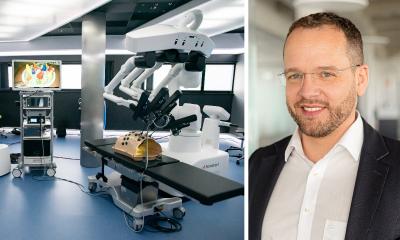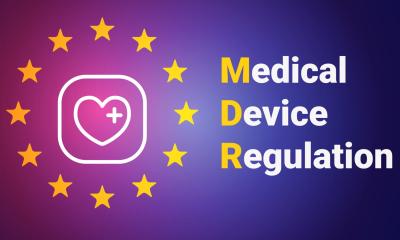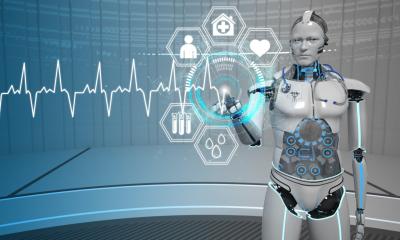Article • A major update
New medical device regulation comes into force
New regulations covering medical devices are set to come into effect across Europe. Originally intended to be implemented in May 2020, the introduction of the updated Medical Device Regulation (MDR) was delayed because of the coronavirus pandemic. The new regulations – the first major update in three decades – now come into force on May 26, and to mark the date a special conference discussed the implications for the MedTech and healthcare sectors with a range of expert speakers assessing if the new MDR will meet its goals.
Report: Mark Nicholls

Among them is Erik Hansson, the Deputy Head of the Unit of the European Commission responsible for the legislation on medical devices, who will discuss the challenges and benefits of the regulations from a European perspective, and focus on two of the main tasks of the European Commission (EC) under the new Regulation, namely the development of implementing acts and guidance documents and the new EUDAMED (European Databank on Medical Devices).
Speaking to Healthcare in Europe ahead of the event, he said: “The new legislation is very ambitious and requires a lot of effort and resources from all actors involved – manufacturers, notified bodies, Member States and the Commission – and will have an important impact on relevant stakeholders, such as healthcare providers.” He said a series of guidance documents developed by the Medical Device Coordination Group, the EC and stakeholders, will help deliver a uniform implementation of the new Regulations across Member States.
The MDR aims to bring EU legislation into line with technical advances, changes in medical science, and progress in law making. He continued: “They create a robust, transparent, and sustainable regulatory framework, recognised internationally, that improves clinical safety and creates fair market access for manufacturers. In contrast to Directives, Regulations do not need to be transposed into national law. The MDR will therefore reduce the risks of discrepancies in interpretation across the EU market.”
The legislation will be [...] applied in not far from half of the countries worldwide that are regulating medical devices
Erik Hansson
The revision of the legislation is the first since the EU acts were drawn up 30 years ago, but will have a wide-reaching impact. Mr Hansson pointed out: “The legislation will be applied both in the EU and in certain countries with which the EU has agreements and will therefore be applied in not far from half of the countries worldwide that are regulating medical devices. It will therefore also have a global impact.”
Compared to the current Directives, the new Regulations emphasise a life-cycle approach to safety, backed up by clinical data and add more stringent rules for the designation of the certification bodies and also add more control and monitoring requirements.
In terms of the impact on healthcare, he said: “The main objective is to ensure efficient and safe medical devices for use in healthcare. It will also bring more transparency for healthcare professionals as the new EUDAMED database includes information on devices which will also be accessible for healthcare professionals once finalised.” Traceability of devices will also improve through a Unique Device Identifier (UDI) system based on the use of barcodes.
Factors that healthcare providers need to consider, he said, should be to make sure that devices are CE-marked, ensuring that the requirements of the legislation are fulfilled. The Regulation contains specific provisions on when health institutions can manufacture, modify and use devices ‘on a non-industrial scale’ in-house when equivalent ones are not available commercially. They also clarify the obligations of manufacturers, authorised representatives, importers and distributors, and both the device and the manufacturer must comply with the MDR.
Manufacturers need to assess the conformity of the device, while other important points of the MDR include requirements on clinical evaluation, risk management, quality management systems, post-market surveillance, technical documentation and other reports and liability for defective devices. Mr Hansson said: “One of the more important aspects for improving patient safety are the reinforced requirements for clinical evaluation. As under the old Directives, it includes the collection of clinical data already available in the literature as well as the setting up of any necessary clinical investigations.”
A key aim of the new regulations is patient safety and the strengthened legislation has improved safeguards to achieve this. “The overall objective is to ensure that patients are treated with safe and effective medical devices,” said Mr Hansson, who added that in general, the MDR retain all the requirements of the old Directives, while adding new measures. “The Regulations will not completely reshape the medical device regulatory landscape, but will ensure that devices manufactured and used in the EU will fulfil the highest standard.”
Recommended article

News • Medical Device Regulation
How the new MDR may hurt patients in the short term
The intentions behind the Medical Device Regulation (MDR) are good. Ultimately, the regulations should prevent inferior medical devices, technologies and pharmaceuticals from endangering peoples’ lives while increasing the quality of drugs and devices entering the market. At the same time, MDR could present several serious immediate challenges to European healthcare systems.
While all new certificates for medical devices will have to be delivered according to the new Regulation from May 26, there is a transitional provision under certain conditions for devices covered by the previous Medical Device Directive. In addition, new regulations on in vitro diagnostic medical devices will become applicable next May. Mr Hansson concluded: “Despite the challenges related to the implementation of the new requirements, in particular, during the Covid-19 pandemic, important progress has been achieved and the new legislation is now ready to be applied in practice. “The work, however, will not stop here as the development of guidance documents is a continuous process that will last for many years to come.
Profile:
Erik Hansson is Deputy Head of Unit for Medical Devices and Health Technology Assessment of the European Commission Directorate General for Health and Food Safety (SANTE), which is responsible for the legislation on medical devices.
25.05.2021









